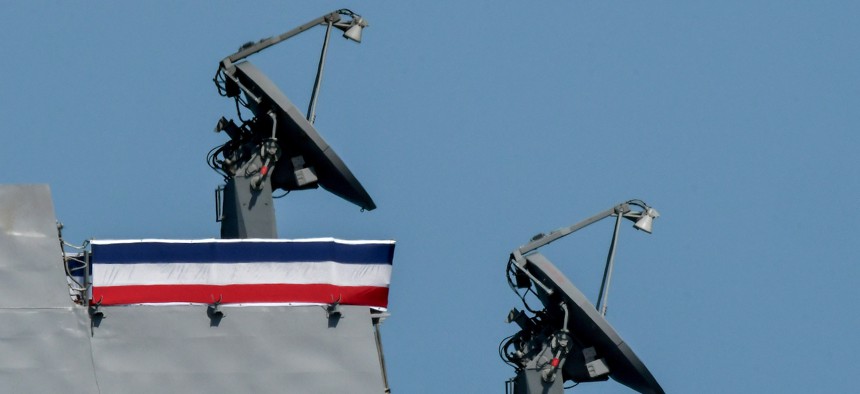
Satellite dishes on the USS Lenah Sutcliffe Higbee, a U.S. Navy Arleigh Burke-class Flight IIA guided missile destroyer. Paul Hennessy / SOPA Images / LightRocket via Getty Images
NRO, Awash in Satellites and Their Data, Hopes AI Can Help It Cope
Artificial intelligence and machine learning could help send information faster and simplify constellation management, said the agency’s director, Chris Scolese.
ST. LOUIS—The Pentagon’s lead space-based surveillance agency wants to use AI and machine learning tools to better manage satellite constellations, National Reconnaissance Office Director Chris Scolese said Tuesday during the GEOINT Symposium.
“We're going from tens of satellites to hundreds of satellites on orbit. We know that users, a broad spectrum of users, want data as quickly as possible. So we have to develop the tools,” with other agencies, including the Defense Intelligence Agency, National Security Agency, and National Geospatial-Intelligence Agency, Scolese said.
That will likely require AI and machine learning to rapidly send information from the satellites to users on the ground in a more usable format, simplifying the management of hundreds of satellites in a constellation in the process.
“We have to be able to process that data quicker, which means we need to deliver the fundamental information to the ground in a way that the analyst or the warfighter or the policymaker can use in the best way. And that may be a direct line, but more likely, it's gonna go through the analytical capabilities at our various organizations to go off and do that,” Scolese said.
NRO is using the experimental satellites it has for operational missions to develop data processes, while figuring out which functions are needed to control constellations without overburdening ground systems.
The Defense Department has been putting more satellites in orbit in recent years and increasingly leans on commercial vendors. Ground systems are a vital part of satellite operations and management, but can be vulnerable to attacks. And if one is compromised, that could cause the failure of multiple satellites in orbit. Earlier this year, Derek Tournear, director of the Space Development Agency, said cyberattacks on ground systems could lead to what is called a common mode failure.
“Common mode failures [such as cyberattacks] can take out all your satellites from the ground systems, then you can't proliferate your way out of that—so that's a major concern. We have a lot of protections in place, and that's something that we put a lot of resources on to make sure that we're hardened against cyber threats,” Tournear said in April.
Ground stations are “one of the key things that's been left out of most conversations in recent decades,” Jim Cooper, a former congressman for Tennessee, said Tuesday at GEOINT. For example, the U.S. government has been delayed for more than a decade in providing the military signals, or M codes, needed to make GPS satellites more secure.
“That is inexcusable, to have a bird flying but it's unusable because we don't have the proper ground legs. The ground part should be the easy part. But oftentimes it's not,” Cooper said.




